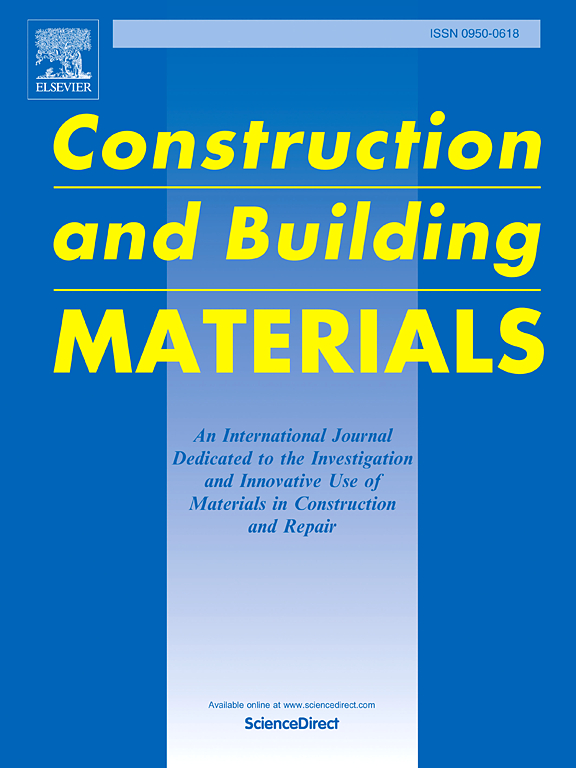Pozzolanic activity of biochar with high carbon content and its influence on comprehensive strength-emission performance of biochar-cement composite paste
IF 7.4
1区 工程技术
Q1 CONSTRUCTION & BUILDING TECHNOLOGY
引用次数: 0
Abstract
Biochar has complex influences on the mechanical properties and carbon emissions of biochar-cement composite concrete. Aiming to prove the beneficial effects of biochar with high carbon content on the compressive strength and carbon-emission reduction of concrete, this study tested the pozzolanic ability of four biochars with their carbon content as high as 78 wt% - 90 wt%, evaluated their pozzolanic activity levels, and further estimated their integrated influences on the compressive strength and carbon emission of biochar-cement composite pastes. The result shows that biochar with high carbon content has pozzolanic activity which is determined by its amorphous SiO2 content as well as carbon content. Biochar-cement composite pastes especially adding biochar with high pozzolanic activity level present good performances, even has the biochar dosage as high as 20 wt%. The compressive strength of composite paste is ideally linked with the sum amount of hydration products from both cement hydration reaction and biochar pozzolanic reaction. The parameter, relative strength-to-emission ratio, is used to evaluate the comprehensive performance of compressive strength and carbon emission of composite paste. For composite paste with biochar dosage of 20 wt%, its value can reach several times to even tens of times higher than that of biochar-free cement paste, showing that biochar with high carbon content has a huge positive effect on the comprehensive strength-emission performance of biochar-cement composite paste.
高含碳量生物炭的火山灰活性及其对生物炭-水泥复合浆体综合强度-发射性能的影响
生物炭对生物炭-水泥复合混凝土的力学性能和碳排放有着复杂的影响。为了证明高碳含量的生物炭对混凝土抗压强度和碳减排的有利作用,本研究测试了碳含量高达78 wt% - 90 wt%的四种生物炭的火山灰能力,评价了它们的火山灰活性水平,并进一步评估了它们对生物炭-水泥复合体抗压强度和碳排放的综合影响。结果表明,碳含量高的生物炭具有一定的火山灰活性,这主要由其无定形SiO2含量和碳含量决定。生物炭-水泥复合膏体特别是添加高火山灰活性水平的生物炭表现出良好的性能,生物炭掺量高达20% wt%。复合膏体的抗压强度与水泥水化反应和生物炭火山灰反应的水化产物的总量有理想的联系。采用相对强发射比参数评价复合膏体抗压强度和碳排放的综合性能。对于生物炭掺量为20 wt%的复合膏体,其数值可达到无生物炭水泥膏体的数倍甚至数十倍,表明高碳含量的生物炭对生物炭-水泥复合膏体的综合强度-发射性能有巨大的积极影响。
本文章由计算机程序翻译,如有差异,请以英文原文为准。
求助全文
约1分钟内获得全文
求助全文
来源期刊

Construction and Building Materials
工程技术-材料科学:综合
CiteScore
13.80
自引率
21.60%
发文量
3632
审稿时长
82 days
期刊介绍:
Construction and Building Materials offers an international platform for sharing innovative and original research and development in the realm of construction and building materials, along with their practical applications in new projects and repair practices. The journal publishes a diverse array of pioneering research and application papers, detailing laboratory investigations and, to a limited extent, numerical analyses or reports on full-scale projects. Multi-part papers are discouraged.
Additionally, Construction and Building Materials features comprehensive case studies and insightful review articles that contribute to new insights in the field. Our focus is on papers related to construction materials, excluding those on structural engineering, geotechnics, and unbound highway layers. Covered materials and technologies encompass cement, concrete reinforcement, bricks and mortars, additives, corrosion technology, ceramics, timber, steel, polymers, glass fibers, recycled materials, bamboo, rammed earth, non-conventional building materials, bituminous materials, and applications in railway materials.
 求助内容:
求助内容: 应助结果提醒方式:
应助结果提醒方式:


